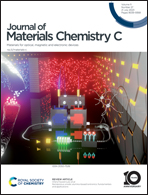Regulated self-powered photoresponse properties and irradiance-adaptable behavior in ferroelectric SrTiO3/TiO2 heterojunction photodetectors†
Abstract
In this paper, SrTiO3 (STO) nanocrystals (NCs) are produced on the TiO2 surface through a second hydrothermal conversion reaction to construct STO/TiO2 core–shell nanorod arrays (NRs) and the amount of STO NCs is controlled by adjusting the conversion time. Here, the self-powered photoresponse properties are demonstrated in STO/TiO2 heterojunction devices. The synergism of the ferroelectric polarization effect of the STO layer and the interface effect of STO/TiO2 heterojunctions on the performance of PDs is investigated. The direction of the ferroelectric depolarization field in the STO layer controlled by an external polarization bias can regulate the magnitude of PD photocurrent, resulting in the enhancement or reduction of the self-powered photocurrent in STO/TiO2 heterojunction PDs without applying bias. The PDs exhibit a self-powered photodetection ability with light irradiance-adaptability and simulate the photopic and scotopic adaptation behavior of eyes. The results suggest a new perspective of using ferroelectric material-based PDs to realize visual servoing in a wide intensity range of light irradiance for machine vision sensors that perceive different lighting environments.



 Please wait while we load your content...
Please wait while we load your content...